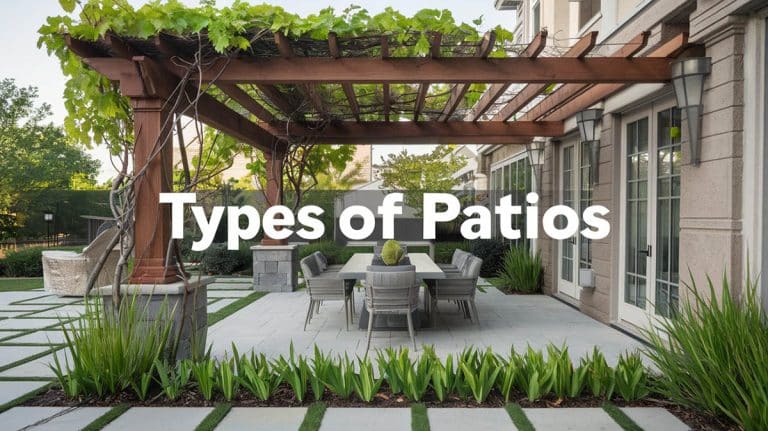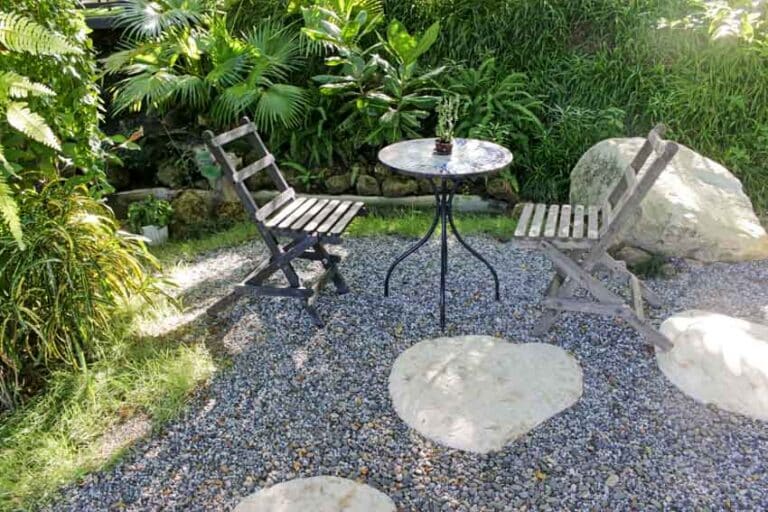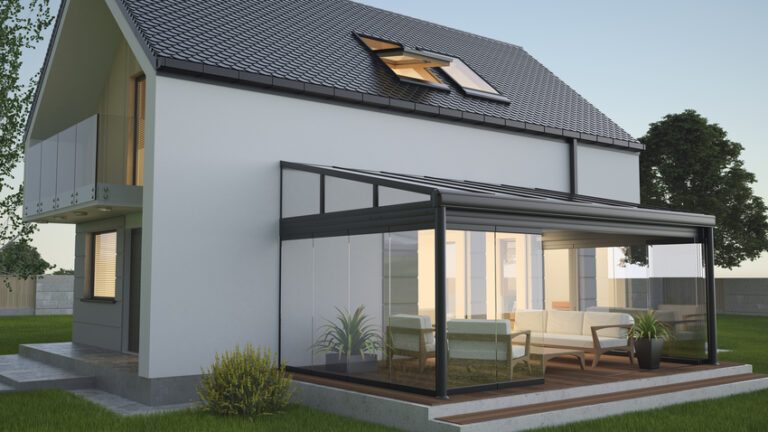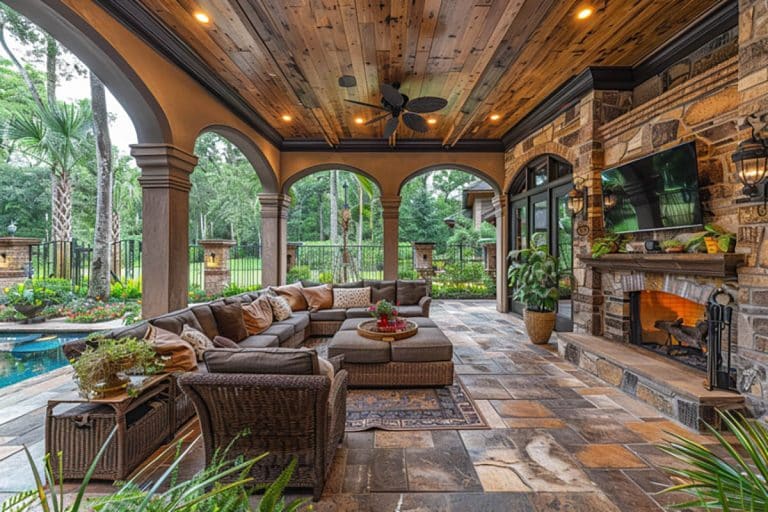Exposed Aggregate Patio (Pros & Cons and Designs)
An exposed aggregate concrete surface is a popular choice for backyard patios and pool decks. it has a textured design that makes it less slippery than many other types of patio materials. In addition, due to its composition of small stones, it makes a stylish-looking patio surface.
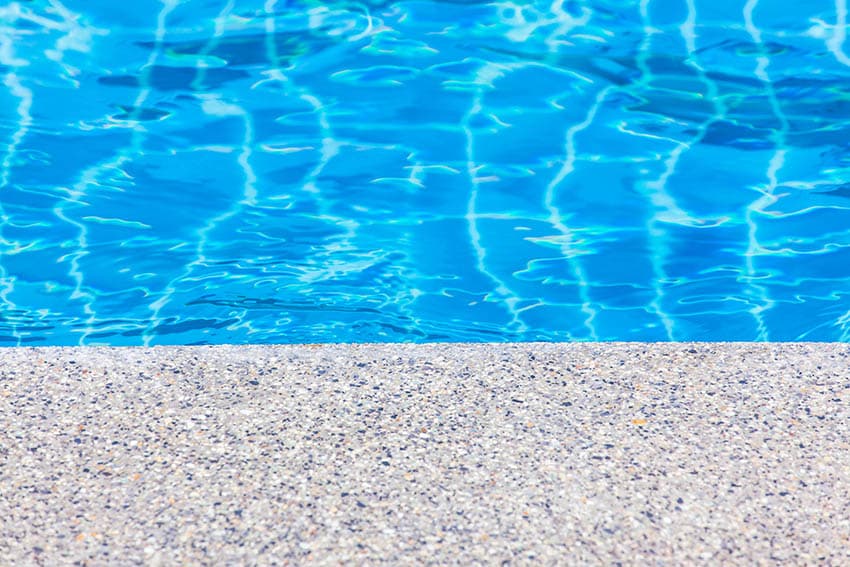
Using exposed aggregates in your patio is a great choice – it is very versatile and you can get quite creative with shape and positioning. You can achieve very interesting designs and layout styles by playing around with colors and materials as well as the size and shape of the aggregate.
What Is An Aggregate Finish Patio?
Exposed aggregate is a popular type of decorative concrete that is created by removing the top outer layer of cement paste to expose the decorative coarse surface in the mix. These aggregates can either be batched into the concrete mix or seeded onto the surface.
The common aggregates used for this concrete finish include decorative stones, gravel, crushed stone, pea stone, crushed glass, quartzite, granite, limestone, and basalts. Aggregates can be fine or coarse.
Due to the unique aesthetic appeal, durability, and skid resistance of the finish, it is ideal to be used for landscaping pathways, sidewalks, driveways, swimming pools, pool & spa decks, driveways, porches, steps, and patios.
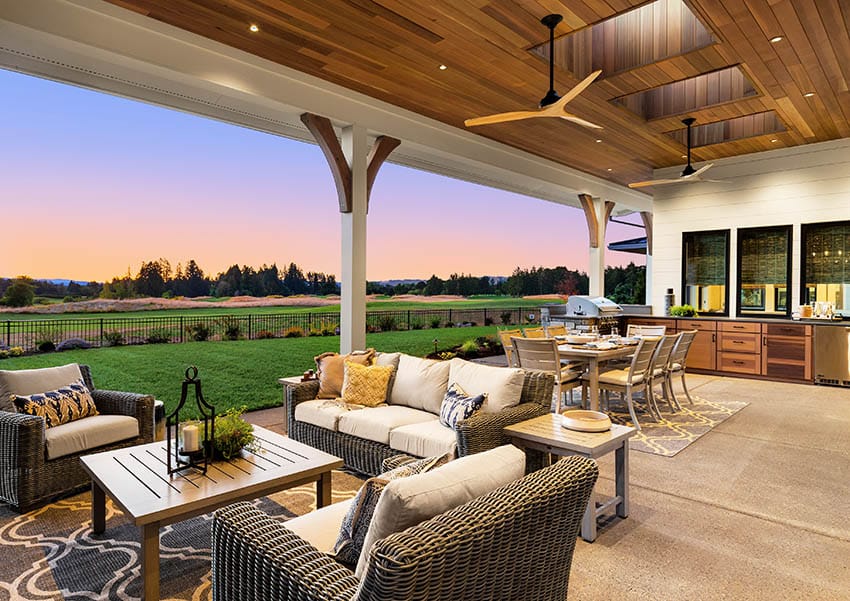
Types of Aggregate Methods for a Patio Design
There are several methods for creating exposed aggregates:
Standard type – It is the most common method that involves mixing or batching the aggregates in the concrete mix.
Topping – This method is also known as concrete overlay wherein aggregates are mixed into a batch and then applied to an existing concrete slab. This method is used in upgrading existing concrete by applying a thin layer of mix at about 1 to 1.5 inches thick.
Seeded – This method is done by placing the decorative aggregates by hand on the surface of a newly poured concrete and then floating them into the material.
Polished – This method is most common for interior surfaces; similar to the standard and topping method this is also known as honing. This is achieved through grinding or sanding the top layer of the concrete to achieve a natural stone and flat matte finish.
There are several ways to expose the aggregate in concrete – usually, it is done through washing or spraying with water and brushing or scrubbing off a thin layer of the cement paste surface until the coarse stone is exposed.
Another method is to use a surface retardant is to spray it on the top layer of the cement paste to slow down the curing process while the underlying concrete hardens. After the concrete sets, the top layer of cement paste is rinsed off using a pressure washer or scrubbed off using a broom and water from a garden hose.
If you want to preserve the color and shape of the exposed aggregate, you can expose it by using abrasive blasting such as sandblasting or shot blasting once the concrete has set and hardened.
Pebble Aggregate For Patio Pros and Cons
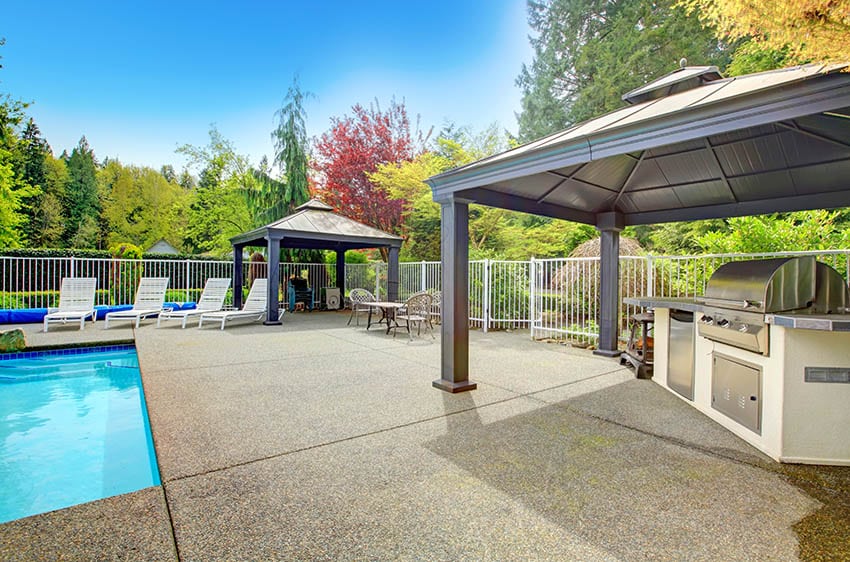
Exposed Aggregate Patio Pros
Match your home’s style – In choosing exposed aggregate as a decorative option for your patio, you can achieve a lot of benefits, such as it is entirely customizable concrete and can blend well and match any exterior décor. Because of its beautiful and unique aesthetic look, it can boost your home’s curb appeal.
Very durable – The exposed aggregate patio is highly durable since it has the structural integrity of concrete, and it can last 40 years or longer. It has a finish that is generally more durable than stamped concrete patios, which is another alternative.
Helps prevent slipping – It holds up well to heavy traffic since the surface is textured and has a skid-resistant quality, especially in wet conditions making your patio surface and walkways safer and reducing the risk of slips and falls.
Stands up to adverse weather conditions – These surface finishes can also withstand exposure to all elements and extreme weather.
Somewhat low maintenance – It also requires moderate maintenance other than occasional cleaning with water and re-sealing every three to five years for protection and to maintain its glossy appearance.
Low cost – Using exposed aggregate for a patio can also be cost-effective to install with its relatively simple procedure and reasonable cost.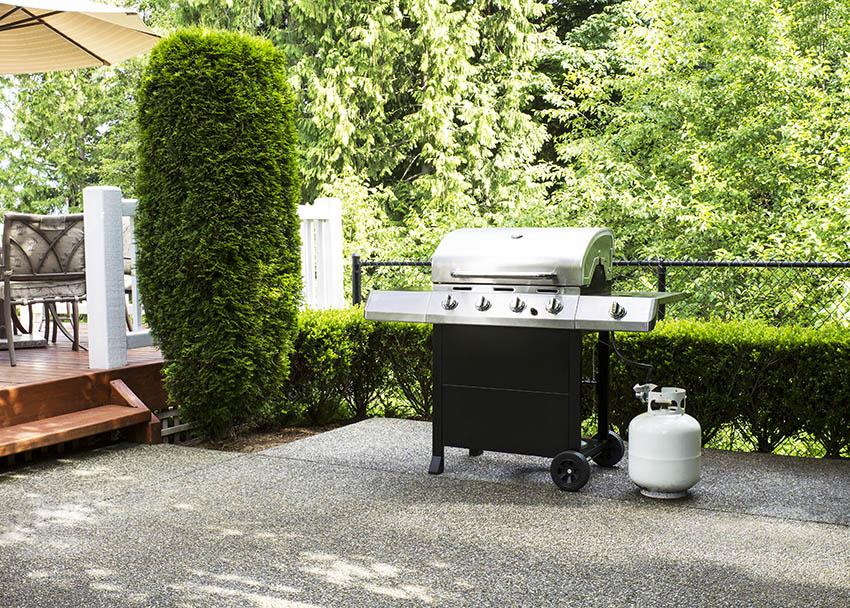
Exposed Aggregate Patio Cons
Though an exposed aggregate patio may be unique and have more aesthetic appeal, it also has several disadvantages to consider before deciding to install.
Can break down if the top concrete layer is damaged – Installation of exposed aggregate poses its own challenge, and one must work carefully to not overexpose the stones regardless of whatever methods one uses.
Exposed aggregate can be as strong and long-lasting as concrete, it is the decorative stones on the top layer which are more prone to damage. In addition, an area like the border or edge of a walkway may be more inclined to chipping or losing stones, especially in a high-traffic area.
There are many factors that can make these exposed aggregates vulnerable to damage such as the movement of heavy objects, water damage can loosen or dislodge the pebbles leaving rough pits in the surface; water can also weaken the bond between the concrete and stones.
Adverse weather with an extreme freeze and thaw cycle may also harm this type of finish. For areas such as this, it may be a good idea to consider other concrete patio finish patterns, like a broom finish, for example.
Difficult to repair – Repairing cracks in exposed aggregate is more difficult since blending the patched surface with the rest of the flooring is the most challenging part. A contractor with experience in landscaping repair is often needed.
Challenging to clean & maintain – Lastly, cleaning and maintenance of exposed aggregates on these types of patios are not as simple as they seem. You really need to scrub with a wire brush and use a powerful hose to wash off all types of dirt that get compacted between the exposed aggregates.
Aggregate Concrete Patio Cost
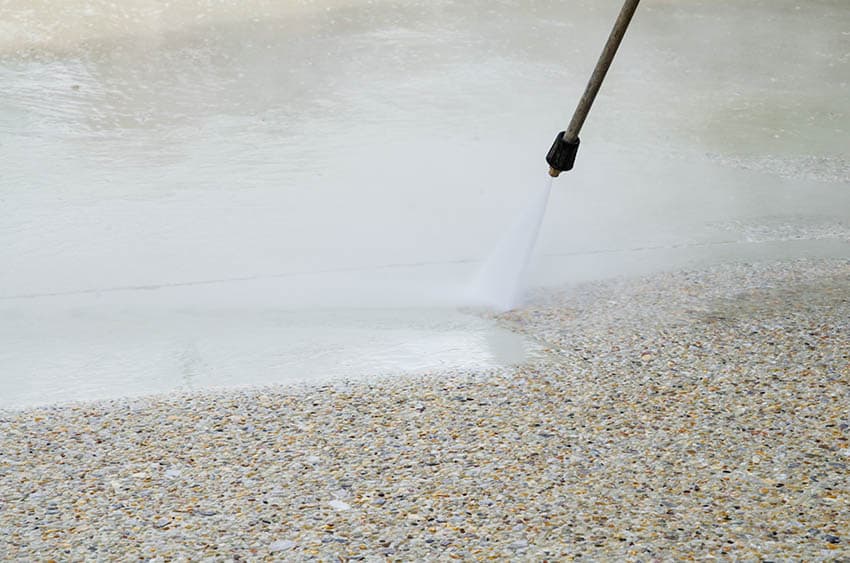
The national average cost of materials to install an exposed aggregate concrete patio is $2.04 per sq foot; raging around $1.90 to $2.18.
The Basic aggregate concrete patio material price for 100 square feet area can cost around $125 to $150 while the Best material price for 100 square feet area can cost around $200 to $235.
The Basic aggregate concrete patio installation cost for 100 square feet area can cost around $150 to $175 while the Best installation cost for a 100 square feet area can cost around $300 to $500.
The average total price for labor and materials per square foot is $10.15 and can cost around $9.11 to $11.18.
For a typical 100 square feet area patio, the Total labor and materials can cost around $275 to $325 for the Basic aggregate concrete patio labor and materials; while the Best aggregate concrete patio Total cost can range from $500 to $735 for both labor and materials.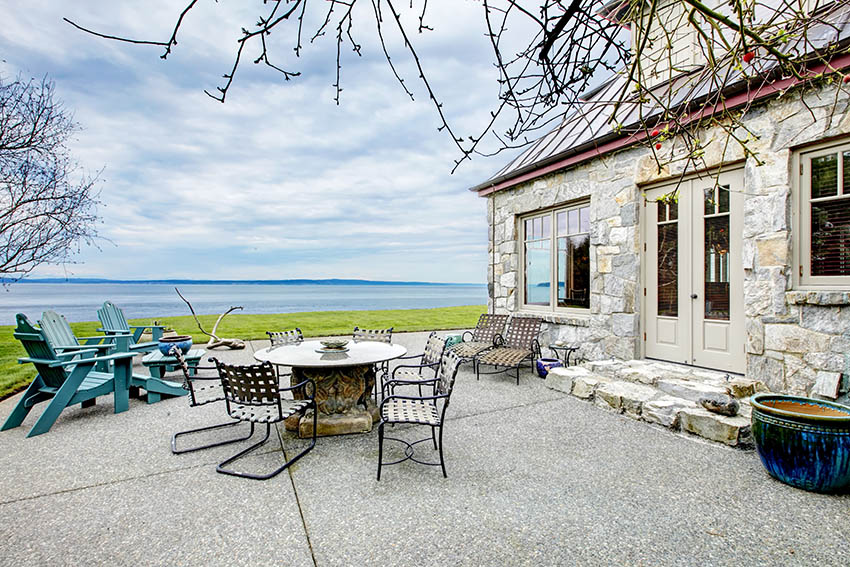
Aggregate Concrete Patio Sealer
The exposed aggregate needs to be sealed to help protect it against spalling, dusting, efflorescence, freeze-thaw damage, stains, and abrasion; it also enhances the color of the surface stones and highlights the aggregates’ depth and richness.
When selecting a sealer for exposed aggregates, there are some elements that you need to check. Make sure that the sealer you choose is non-yellowing and UV resistant, the sealer should repel oil, grease, water, and stains.
The sealer needs to provide a high-gloss wet look – this is an element that deepens and enriches the color of the stones.
There are two best types of sealers for exposed aggregates – Water Repellent Concrete Sealers and Acrylic Concrete Sealers.
Water Repellent Concrete Sealers – Water Repellent Concrete Sealers won’t change the look of the surface finish, they work below the surface and last 7 to 10 years. This type of sealer repels surface water and reduces staining and deterioration; and can be used on cured and uncured concrete.
Acrylic Concrete Sealers – On the other hand, Acrylic Concrete Sealers enhance the aggregates with a wet look or gloss while leaving a visible surface film lasting 1 to 5 years. This type of sealer also protects the surface against staining, stops dusting and deterioration; and just the same can be used on cured and uncured concrete.
It is important to make sure that all cement paste residue has been removed when applying the sealer to fresh concrete in order to avoid sealing the milky-looking white paste on the surface.
If you need to apply sealer on existing exposed aggregate make sure that the surface is thoroughly clean and free from oil, grease, dirt and stains before applying the sealer.
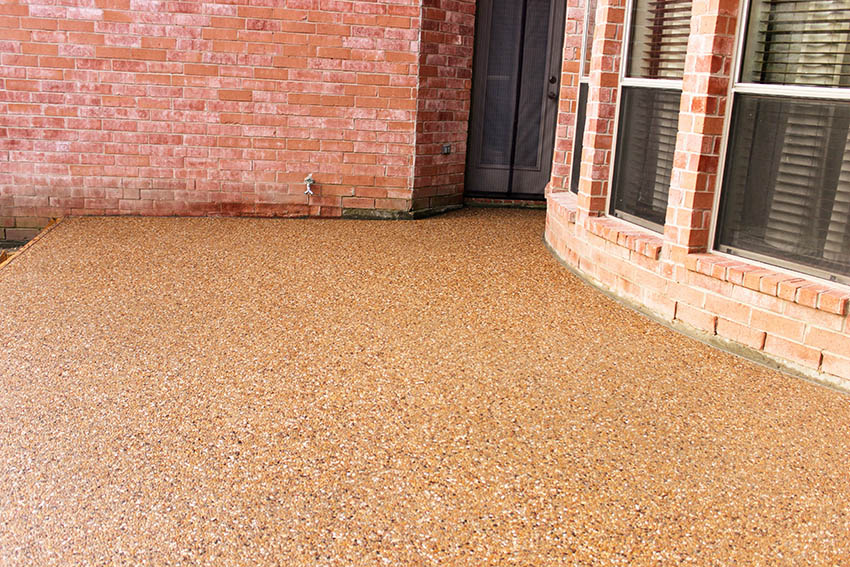
Cleaning An Aggregate Surface
As time passes by, the exposed aggregate patio will get dirtier since it will be gathering dirt, dust, and debris. Regular maintenance and cleaning are of utmost importance to protect your exposed aggregate patio and retain its fantastic look.
Ideally, sweeping your patio at least once a day keeps it free from dust, dirt, and debris. For stain spots and stubborn dirt, rinsing the surface with water using a garden hose is a good idea.
To eliminate oil and grease stains, use a high-pressure washer with hot water to help lift the oil and grease from the surface and apply a cleaning solution that will break down the stain; doing so, allows the oil and grease to wash off easily.
Usually, a cleaning solution will just call for a dishwashing liquid or baking soda; but tough oil and grease might need a commercial-grade degreaser to do the job.
Any moisture that is left to settle on your patio which, at the same time has very little sunlight can easily start to form mold and algae. These molds and algae are to be cleaned by using a chemical solution and washing it out with a high-pressure cleaner.
It is important that whenever you are using a chemical cleaning solution, your exposed aggregate patio needs to be rinsed and allow the surface to completely dry. We hope that we have presented you with a lot of options for incorporating exposed aggregate onto your patio and anywhere you see it fit the landscape of your home.
For more related content visit our stone patio ideas page.

